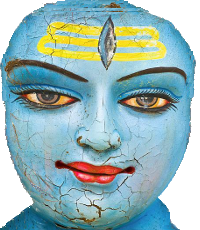The Buddhas of Bamiyan
In Bamiyan, a valley in central Afghanistan, two gigantic Buddha statues were constructed in the sixth century CE. Hewn directly out of the sandstone cliff, they were 35 and 53 meters tall respectively, and the largest standing Buddha statutes in the world. The Bamiyan Buddhas were wonderful examples of the eclectic blend of cultural influences that characterized Bactria – the Buddhas were Indian enough, but they were wearing Greek clothing.
Introduced to Afghanistan already in the fourth century BCE, Buddhism flourished during the Kushan empire. At the time Bamiyan was a hub on the caravan routes which connected India, Central Asia and China. From the monasteries constructed here Buddhist influences spread far and wide. A Chinese pilgrim, Xuanzang, who visited Bamiyan in 630 CE, mentioned “more than ten monasteries and more than a thousand monks” living there. [Read more: ”Journey to the West”] The hermit monks had dug caves for themselves in the rock face, each one painted with brightly colored frescoes. Xuanzang also noted that two two enormous Buddha statues were “decorated with gold and fine jewels.”
The statues were destroyed by the Taliban government in March 2001. To the Talibans they were “idols,” and they were angry that the international community allocated funds for maintaining the statues while the Afghans themselves were starving. The destruction was carried out in stages and it took weeks to complete. Initially, the statues were fired at using anti-aircraft guns and artillery but eventually they were dynamited. Public opinion world-wide was outraged by this act of cultural vandalism.
Various proposals have been made for reconstructing the statues, using what can be recovered of the original stones. In 2013, the foot section of the smaller Buddha was rebuilt with iron rods, bricks and concrete, but the work has halted after protests from Unesco. Some have felt that the statues should not be rebuilt but the niches left empty as a monument to the fanaticism of the Taliban. In June 2015, the statues were temporarily recreated by means of hologram images projected onto the cliffs. There is no doubt that the Buddha himself would have said about the destruction of the statues. “Nothing in this world is for ever,” he would have pointed out, “everything must pass.”
External links:
- “Buddha collapsed out of shame”
- Afghan Tourist Organization, “Buddhas of Bamiyan,” 1967
- BBC News, “Artist to recreate Afghan Buddhas”
- Christian Frei, “The Giant Buddhas”
- CNRS, “Secrets of the Bamiyan Buddhas”
- Community of Bamiyan development
- European Synchrotron, “Secrets of Bamiyan Buddhist murals”
- FBI, “ISIL and Antiquities Trafficking”
- Japan Today, “Japan offered to hide Bamiyan statues, but Taliban asked Japan to convert to Islam instead”
- Mullah Omar, “We are hunting Americans like pigs”
- Sumpa Khan-po Yeçe Pal Jor, History of the rise, progress and downfall of Buddhism in India
- Unesco, “Bamiyan photo gallery”

